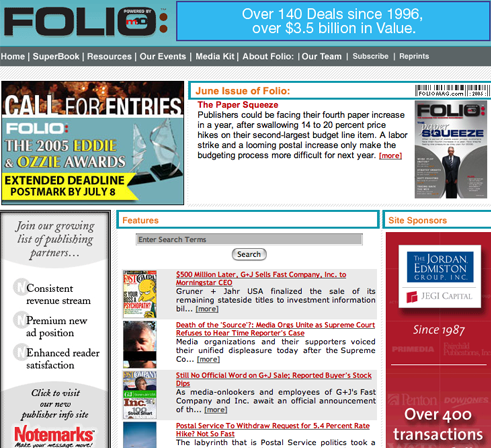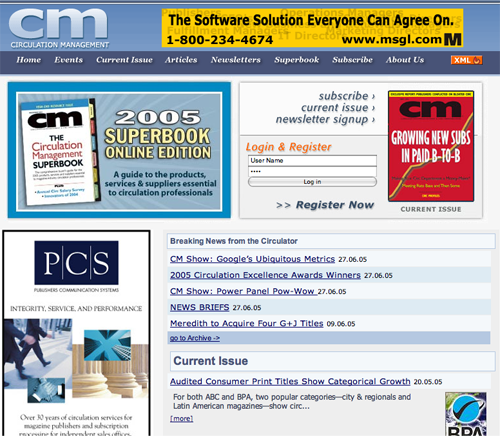The folks at Red 7 Media understand that readers consume information in a variety of ways—in print, online, and in person. “Therefore,” says Editor and Publisher Tony Silber, “it’s our job to come up with a variety of marketing techniques that will work for our advertisers.”

It’s our job to come up with a variety of marketing techniques that will work for our advertisers.
—Editor and Publisher Tony Silber
In fact, the company offers a whole array of online and offline advertising and sponsorship opportunities that are targeted to its four B-to-B magazine brands—Folio:, Circulation Management, Event Marketer, and, launching in October 2005, Event Design Magazine. All four print magazines are advertising-based, controlled-circulation products. Visitors to the respective magazine websites can opt in to receive ad-sponsored e-newsletters (M10 Alert for Folio:, The Circulator for CM, and EM Buzz for Event Marketer) delivered weekly, and can also access the free online directories (Superbooks) of suppliers, vendors and other resources. And each magazine hosts one or more well-attended industry conferences each year. T
Tony Silber was long associated with both Folio: and Circulation Management (CM) magazines, but Red 7 Media only recently acquired the two titles—in August 2004—from Primedia Business Publications. Readers and advertisers alike should be pleased, though, that the two long-standing “bibles” of publishing management were passed along to committed leadership. Both audiences can also feel confident that Red 7 Media has its collective eye well placed on the future. “We’re applying a much more robust multimedia approach to Folio: and CM,” says Silber. And that, of course, means undertaking interesting and innovative revenue-producing website strategies.
Event and conference sponsorships and related attendee fees produce large chunks of annual revenue, but advertising is the company’s primary revenue generator. Advertiser dollars, therefore, are the focus of many of Red 7 Media’s new and planned ideas. 
Sponsored Content “Channels”
The company’s most exciting new initiative is the creation of sponsored content “channels,” or micro-sites, incorporated into its various magazine websites. A dynamic reader/visitor resource for consolidated service information, each channel will include an array of information on any given magazine industry topic, such as white papers, research, market intelligence from suppliers and content from other media. Red 7 Media will sell exclusive sponsorships against each channel.
For example, an advertiser might be an appropriate sponsor for a “reprint” or “short-run printing” or “mergers and acquisitions” channel on Foliomag.com or for a “telemarketing services” or “fulfillment services” channel on Circman.com. The exclusive sponsor may post content such as articles and tips, as well as marketing information that it generates itself. This concept, which locks out competitors, is much more valuable to the sponsor than simply buying online ad space that links back to its own website. Everyone benefits:
- The sponsor, by association…from the magazine’s authority within the publishing industry, as well as added visibility on the magazine’s website;
- Site visitors…from the ability to find specific, relevant information on an area of interest without having to fish around the site or use outside search engines; and
- Red 7 Media…from the positioning of its websites as the source of information on key topics in the industry.
“Obviously,” says Silber, “we’ll very clearly identify these pages [as being sponsored]; but it’s a compelling idea for a marketer to be able to leverage the traffic that comes to our websites looking for answers.” For Folio:, that traffic averages 50,000 to 60,000 unique visitors per month—unique visitors being the “most legitimate and most basic” method of calculating traffic, according to Silber; for CM, it’s about 30,000 unique visitors per month. And the exclusive sponsor will own the space and any conversation that appears in the selected channel. Visitors, of course, can navigate and/or search throughout the magazine’s site from each channel page. 
Job Board for the Publishing Industry
Also in the works at Red 7 Media is an online job board. “That’s a real opportunity for us,” says Silber. “People contact us all the time to post job listings in our newsletters. In the last six months or so, the requests have been going through the roof! We’ve included two or three job listings in each issue of each newsletter. Other entities in the publishing industry do some job posting on their websites, but we hold a dominant position in that space. When people think about magazine industry jobs, they should—and do—think about us. So we want to help them out.”
Job recruitment today is very much an online exercise, so it is certainly smart for Folio: and CM, especially, to provide that service to its publishing industry audience. For both the company looking to hire and the individual seeking a job, a targeted, industry-specific, online job board cuts through all the clutter of unrelated job listings posted on general job boards. For the magazine hosts, of course, the benefit is added revenue from the listing fees with little hands-on oversight required—particularly if the operation is outsourced.
Silber indicates that the company is contemplating a two-pronged approach, offering: a high-end job service for high-level executive positions, and a separate job board for all other industry positions. While all the wrinkles have yet to be ironed out, including timing and whether a service (or which service) will operate the system for the magazine(s), this is a front-burner project. The expectation is that the company that posts the job will pay a listing fee, and the job seeker will be able to respond to the listings for free.
Archives—Paid or Free—and Other Ideas
Currently, access to every part of Red 7 Media’s four magazine-branded sites is user-accessible for free. Anyone who wants to receive one of the weekly email newsletters must register, however, as each is an opt-in publication. Some areas of the sites also require (or will require) user registration—e.g., the sponsored content channels—enabling the company to monitor traffic and create a database of email addressees and other information. The channel sponsors receive contact information on visitors, as well.
Down the road, according to Silber, access to archived material may also require registration—”or,” he says, “the archives may become pay-per-view.” All the Folio: and CM articles and other content dating back to the acquisition (August 2004), along with all the M10 Alert and Circulator email newsletters, are archived on the respective sites, and that material is currently accessible for free. The newsletters, incidentally, are all individual entities that contain first-run, complete articles with inherent value of their own. The newsletters are not simply used for promotional reasons or to drive traffic to full articles posted on the websites—although they also deliver on those objectives, as newsletter articles link to related ares of the website.
Years’ worth of archived material for both Folio: and CM, when they were owned by Primedia, is also available to Red 7 Media, but that material has not yet been posted to the sites. “We do have it,” says Silber. “Upon the acquisition, Primedia gave us about 80,000 pages of material that we still have to format. We’re building the archives now, so the availability of that content is just a matter of time.” Hence, the consideration of how the archives will be treated—user registration or pay-per-view access—once those areas are fully up and running.
Adding a premium (paid-membership) area to one or more of the sites is “definitely under consideration,” he adds. “We don’t have a specific strategy in mind at this time, and I’m not sure what the exact model would be; but that’s on the back burner.”
Another strategy under consideration but not yet active is the possibility of sponsored webinars, where a company will pick up the tab for a 45-minute or hour-long interactive online discussion on a topic of interest to visitors and of obvious interest to the advertiser. “I’d like to do webinars sooner rather than later,” Silber says, “but it’s a question of selling them and also whether the advertisers who are already spending the most money with us are ready or willing to spend another $15,000 or so to buy into a webinar.”
Of course, the other option is a “pay-to-participate” scheme, where anyone wishing to join the webinar pays a small fee that, in the aggregate, would pay the costs plus generate revenue for Red 7 Media. As with the online job board, services are available to pull together the webinar technology and handle all the details, leaving little work and even less stress for the host company.
Since the Red 7 Media people all can legitimately claim long and successful experiences hosting annual industry conferences and awards events, it would be a cinch to combine an interactive element with any or all of those shows—and, perhaps, also host interim online events. For every person who attends a live business event, the thinking is, five more people back in the office wanted to go but didn’t get the chance due to logistics, cost or some other reason. Now that seems like a made-to-order audience!
Conclusion
So, just as Rome wasn’t built in a day, Tony Silber finds it’s difficult—and perhaps unwise—for his company to take on too much at once. No matter. Red 7 Media, with its venerable brands and experienced people, has a firm foundation. And Silber and his associates appear poised to build, brick by brick, robust websites that will undoubtedly help maintain the reputation of their various brands as “go to” sources of industry information.


